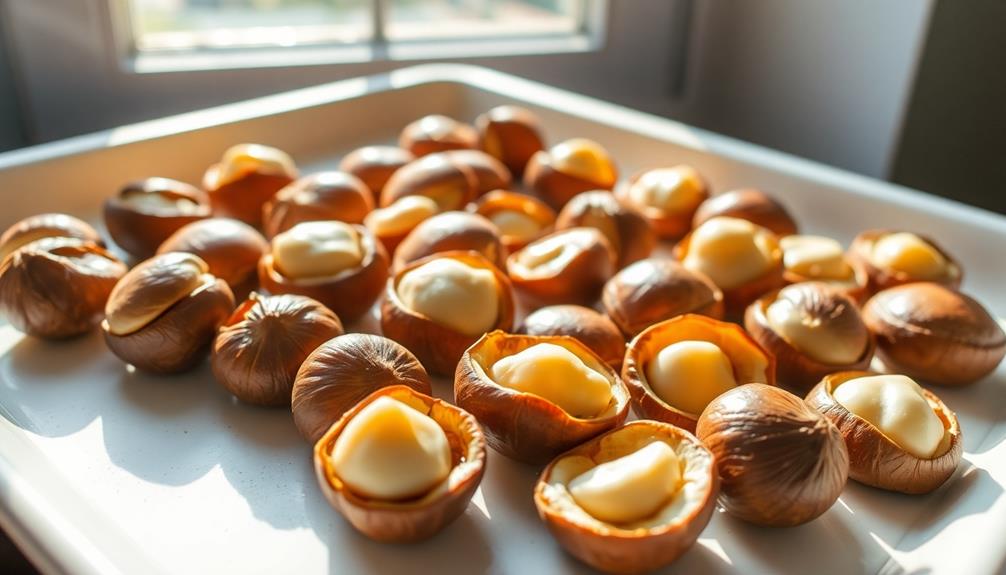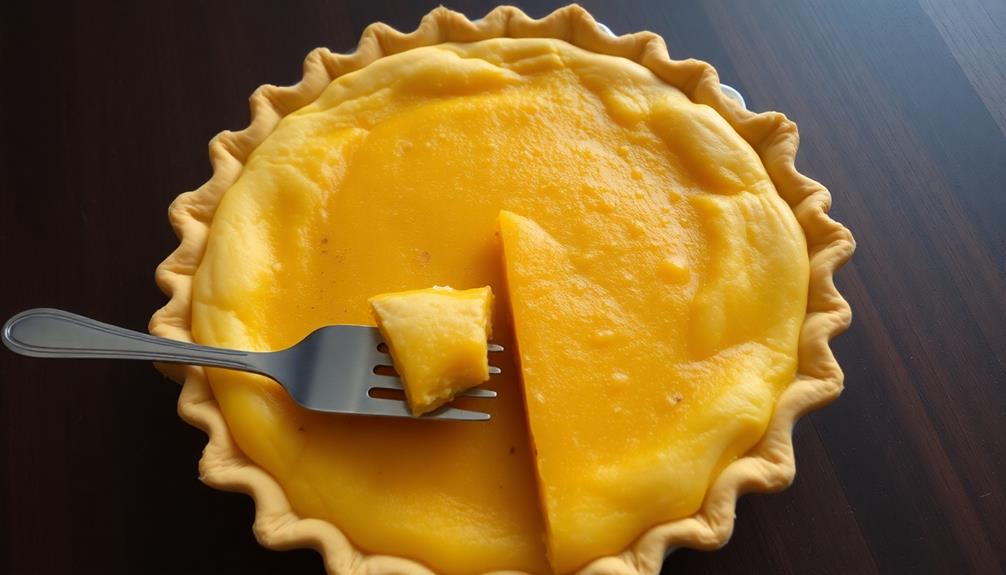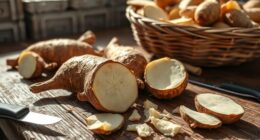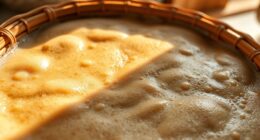Stuffing, or dressing, is a beloved holiday side dish with ancient roots. You'll typically find it made from bread cubes, herbs, and vegetables, often served alongside poultry. To make it, you'll sauté aromatics like onions and celery, then mix them with seasoned bread and broth. You can customize it with ingredients like apples, cranberries, or nuts to suit your taste. Whether you cook it inside the bird or separately, the key is achieving the right moisture balance and a golden-brown top. This versatile dish holds cultural significance, representing family traditions and adding comfort to festive meals. Exploring its rich history and variations can enhance your appreciation for this classic dish. If you’re looking to add a unique twist to your holiday stuffing, consider trying an oyster stuffing recipe. This regional variation is popular in the southern United States and adds a savory and briny flavor to the dish. By experimenting with different stuffing recipes, you can create a new tradition for your family gatherings and continue to appreciate the cultural significance of this timeless holiday dish.
Key Takeaways
- Stuffing is a savory dish made of bread, herbs, and vegetables, often served as a side during holiday meals.
- The terms "stuffing" and "dressing" are used interchangeably, though dressing is typically cooked outside the bird.
- Key ingredients include day-old bread, butter, onions, celery, herbs, eggs, and broth.
- Preparation involves sautéing vegetables, mixing with bread and seasonings, and baking until golden brown.
- Stuffing can be customized with various ingredients like fruits, nuts, or meats to suit regional or personal preferences.
History
Throughout history, stuffing has been a beloved accompaniment to roasted meats.
You'll find that this culinary tradition dates back to ancient times, with Roman cookbooks mentioning stuffed animals as early as the 4th or 5th century.
As you explore the origins of stuffing, you'll discover that it wasn't always made with bread. In fact, early versions often included a mixture of herbs, spices, and organ meats.
During the Middle Ages, stuffing became increasingly popular in Europe.
You'd have seen it used not only in poultry but also in fish and vegetables. The term "forcemeat" was commonly used to describe these mixtures, which were often quite different from the bread-based stuffings you're familiar with today.
In America, stuffing has been a Thanksgiving staple since the holiday's inception.
You might be interested to know that the first recorded recipe for turkey stuffing appeared in 1792.
Over time, regional variations developed, reflecting local ingredients and tastes.
Whether you call it stuffing or dressing, this dish has evolved into a cherished part of many holiday meals.
Recipe
Stuffing, also known as dressing in some regions, is a beloved side dish often associated with holiday meals, particularly Thanksgiving. This savory mixture of bread, herbs, and vegetables is traditionally used to stuff poultry but can also be baked separately as a standalone dish.
While there are countless variations of stuffing recipes, this classic version combines the comforting flavors of sage, thyme, and parsley with the satisfying texture of toasted bread cubes. The addition of celery, onions, and garlic creates an aromatic base that infuses the dish with rich, savory notes.
- 1 pound day-old bread, cut into 1-inch cubes
- 1/2 cup unsalted butter
- 2 medium onions, diced
- 4 celery stalks, diced
- 4 cloves garlic, minced
- 1/4 cup fresh sage, chopped
- 2 tablespoons fresh thyme leaves
- 1/4 cup fresh parsley, chopped
- 2 large eggs, beaten
- 2 cups chicken or vegetable broth
- Salt and pepper to taste
Preheat the oven to 350°F (175°C). Spread the bread cubes on a baking sheet and toast for 10-15 minutes until lightly golden. In a large skillet, melt the butter over medium heat and sauté the onions, celery, and garlic until softened.
Add the herbs and cook for another minute. In a large bowl, combine the toasted bread cubes, sautéed vegetables, beaten eggs, and broth. Mix well and season with salt and pepper. Transfer the mixture to a greased baking dish and cover with foil. Bake for 30 minutes, then remove the foil and bake for an additional 15-20 minutes until the top is golden brown and crispy.
For a moister stuffing, add more broth; for a drier texture, use less. You can customize this recipe by adding ingredients like chopped apples, dried cranberries, or toasted nuts.
If you prefer a vegetarian version, simply substitute vegetable broth for chicken broth. To make ahead, prepare the stuffing up to the point of baking, refrigerate, and bake just before serving, adding an extra 10-15 minutes to the cooking time.
Cooking Steps
To make your stuffing, you'll follow a few key steps that'll ensure a delicious result.
First, you'll preheat your oven to 350°F and sauté your vegetables in butter, creating a flavorful base.
Then, you'll add bread and seasonings, followed by broth, mixing thoroughly before baking the stuffing until it's golden brown and crispy on top.
Step 1. Preheat Oven to 350°F
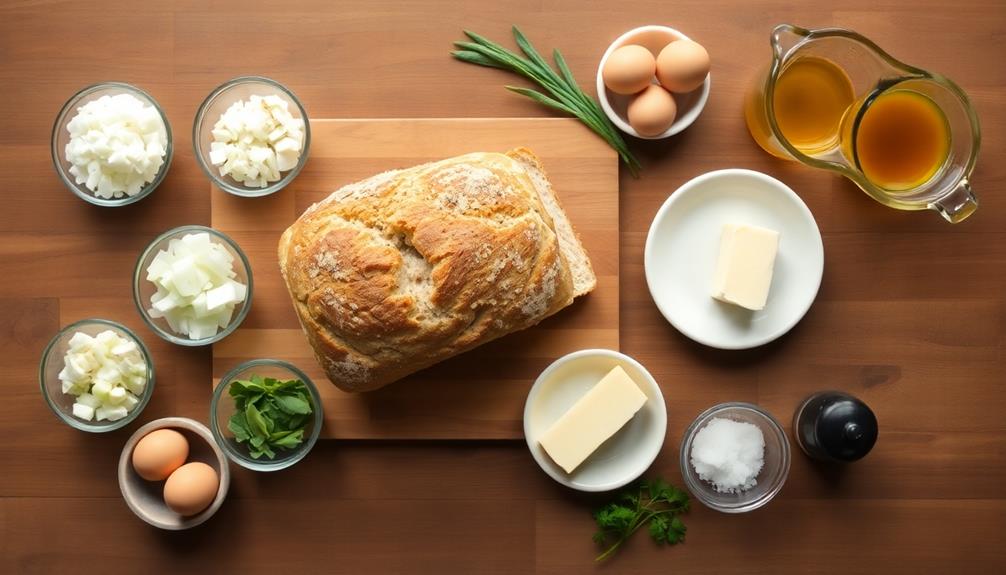
The initial step in preparing your stuffing is to preheat the oven to 350°F (175°C). This temperature is crucial for achieving the perfect balance of crispy exterior and moist interior in your stuffing.
While the oven's heating up, you'll have time to prepare the other ingredients and assemble your dish.
Preheating serves several important purposes:
- It ensures even cooking throughout the stuffing
- It helps create that desirable golden-brown top
- It reduces overall cooking time
Don't be tempted to skip this step or start with a cold oven. Proper preheating can make the difference between a mediocre and a mouth-watering stuffing.
If your oven has a preheat indicator, wait for it to signal before placing your stuffing inside. For older ovens without this feature, allow about 15-20 minutes for preheating.
Step 2. Sauté Vegetables in Butter
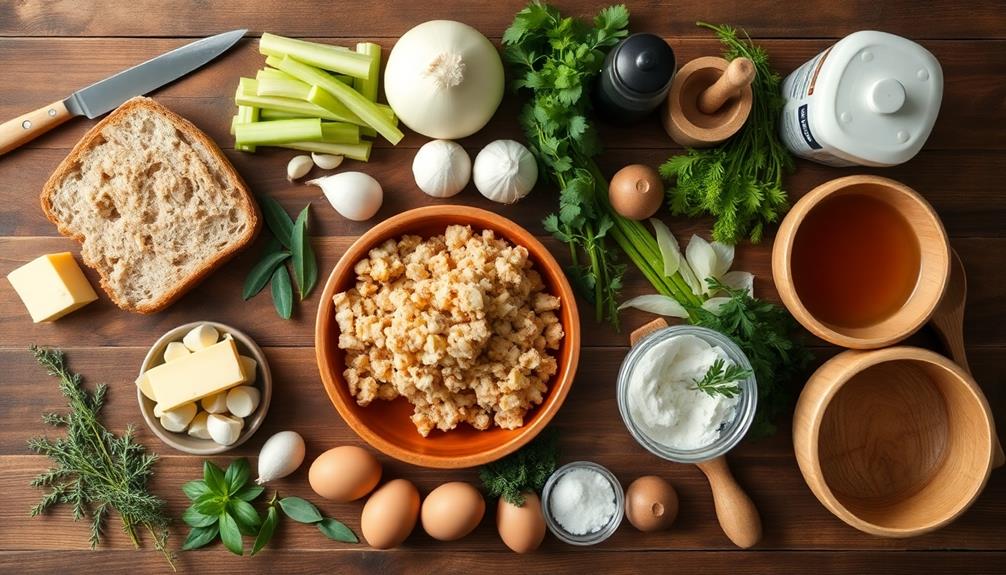
Sautéing vegetables in butter is a crucial step that lays the foundation for a flavorful stuffing. To begin, finely chop your aromatics:
- 1 large onion
- 2-3 celery stalks
- 2 carrots (optional)
In a large skillet over medium heat, melt 1/2 cup of unsalted butter. Once it's bubbling, add your chopped vegetables. Stir them frequently, allowing them to cook for about 8-10 minutes until they're soft and translucent.
The onions should turn slightly golden, but be careful not to let them brown too much. As you sauté, you'll notice a wonderful aroma filling your kitchen. This process is key to developing deep, rich flavors in your stuffing.
The butter not only adds richness but also helps to soften the vegetables and release their natural sweetness. If you'd like to enhance the flavors further, consider adding:
- 2-3 cloves of minced garlic (in the last minute of cooking)
- 1 tablespoon of fresh thyme or sage
Once your vegetables are soft and fragrant, they're ready to be combined with the other stuffing ingredients.
Step 3. Add Bread and Seasonings

Once your vegetables are sautéed to perfection, it's time to add the bread and seasonings. This step is crucial for creating the perfect texture and flavor profile of your stuffing. Here's what you'll need to do:
- Choose your bread: Use day-old bread that's slightly dried out. This helps absorb flavors better. Cube it into small, bite-sized pieces.
- Add herbs and spices: Common choices include sage, thyme, rosemary, and black pepper. Don't forget salt to enhance all the flavors.
- Mix it all together: Combine the bread cubes with your sautéed vegetables in a large bowl. Toss gently to distribute everything evenly.
- Pour in broth: Gradually add warm chicken or vegetable broth until the bread is moistened but not soggy. The amount will vary depending on your bread type.
- Let it rest: Allow the mixture to sit for a few minutes, giving the bread time to absorb the flavors and liquid.
Step 4. Add Broth and Mix Thoroughly
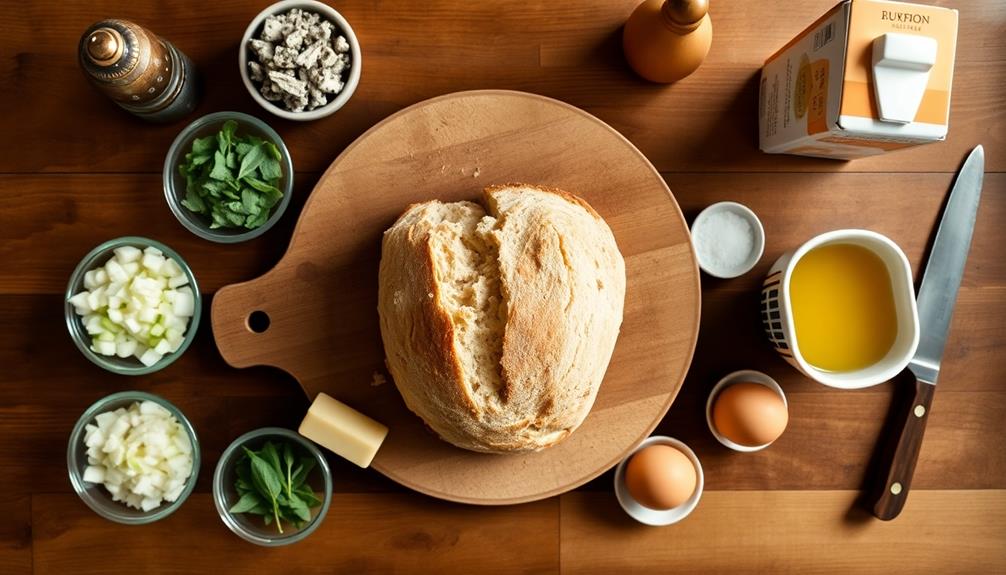
Adding broth and mixing thoroughly is a critical step in creating the perfect stuffing texture. As you pour the broth over your bread and seasoning mixture, you'll want to add it gradually, ensuring even distribution. The amount of broth you'll need depends on your desired consistency, but typically, you'll want enough to moisten the bread without making it soggy.
Here's how to proceed:
- Start by adding about half the broth you think you'll need.
- Use a large spoon or your hands to gently mix the ingredients, incorporating the liquid.
- Continue adding broth in small increments, mixing after each addition.
- Pay attention to the texture – you're aiming for moist but not wet.
As you mix, be sure to break up any large clumps of bread. This process helps distribute flavors evenly and creates a uniform texture.
Don't overmix, though, as this can lead to a gummy consistency. Once you've achieved the right moisture level and everything is well combined, your stuffing is ready for the next step – whether that's stuffing the bird or baking in a separate dish.
Step 5. Bake Until Golden Brown
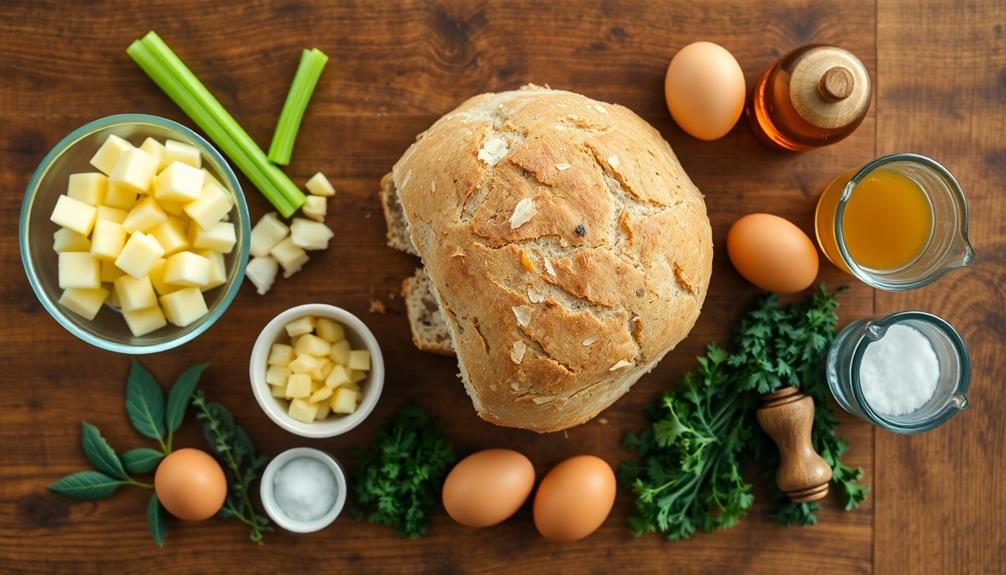
With your stuffing mixed to perfection, it's time to bake it until golden brown. Preheat your oven to 350°F (175°C) and transfer the stuffing to a greased baking dish. Spread it evenly, ensuring a consistent thickness throughout.
Cover the dish with aluminum foil and place it in the preheated oven. Bake for about 30 minutes, allowing the flavors to meld and the stuffing to heat through.
Then, remove the foil and continue baking for an additional 15-20 minutes. This uncovered baking time is crucial for achieving that coveted golden-brown top.
Keep a close eye on your stuffing during the final minutes of baking. You're looking for a crispy, golden-brown surface with a moist interior. If you prefer a crunchier top, you can broil it for 2-3 minutes, but be careful not to burn it.
Once it's reached your desired level of golden-brown perfection, remove the stuffing from the oven. Let it cool for a few minutes before serving. This cooling period allows the flavors to settle and makes it easier to portion out.
Final Thoughts
Stuffing, whether cooked inside the bird or separately as dressing, remains a beloved holiday staple. Its versatility and comforting flavors make it a dish that's cherished across generations.
As you've seen, creating the perfect stuffing isn't just about following a recipe; it's about understanding the ingredients, techniques, and traditions that make this side dish special.
Remember, you can always experiment with different herbs, spices, and add-ins to create your own signature stuffing. Don't be afraid to mix things up by trying various bread types or incorporating regional ingredients.
The key is to keep the basics in mind:
- Use stale bread for the best texture
- Balance moisture levels carefully
- Season generously
- Cook to the proper temperature for food safety
Whether you prefer your stuffing moist or crispy, packed with herbs or studded with fruits and nuts, the most important thing is that it brings joy to your table.
With practice and a bit of creativity, you'll soon be known for your delicious stuffing that everyone looks forward to year after year.
Frequently Asked Questions
Can Stuffing Be Prepared in Advance and Frozen?
Yes, you can prepare stuffing in advance and freeze it! Here's what you need to know:
- Make your stuffing recipe as usual, but don't bake it yet.
- Let it cool completely, then transfer to a freezer-safe container.
- Freeze for up to 3 months.
- When ready to use, thaw in the refrigerator overnight.
- Bake as directed, adding about 15 minutes to the cooking time.
This method saves time and ensures you'll have delicious stuffing ready for your special meal!
What's the Difference Between Stuffing and Dressing?
You might be surprised to learn that stuffing and dressing are essentially the same dish! The main difference lies in how they're cooked.
Stuffing is traditionally prepared inside the turkey, while dressing is cooked separately in a baking dish. However, many people use these terms interchangeably.
Regional preferences also play a role; in the Southern U.S., you'll often hear "dressing" regardless of the cooking method.
Both are delicious holiday staples made with bread, herbs, and other tasty ingredients!
How Long Can Leftover Stuffing Be Safely Stored in the Refrigerator?
You'll want to consume your leftover stuffing within 3-4 days for optimal safety and flavor.
After cooking, let it cool completely before storing it in an airtight container in your refrigerator.
Don't leave it at room temperature for more than 2 hours.
When you're ready to reheat, make sure it reaches an internal temperature of 165°F (74°C) to kill any potential bacteria.
If you can't eat it within 4 days, consider freezing it for longer storage.
Is It Safe to Stuff a Turkey With Stuffing?
While it's possible to stuff a turkey, it's not recommended for safety reasons.
When you stuff a turkey, the stuffing may not reach a safe temperature to kill harmful bacteria. Instead, you're better off cooking the stuffing separately in a casserole dish.
If you really want to stuff your bird, use a food thermometer to ensure the center of the stuffing reaches 165°F (74°C).
Can Stuffing Be Cooked in a Slow Cooker or Instant Pot?
Yes, you can definitely cook stuffing in a slow cooker or Instant Pot!
These appliances offer convenient alternatives to traditional oven methods. For slow cookers, you'll want to cook on low for 3-4 hours, stirring occasionally.
In an Instant Pot, use the sauté function to toast ingredients first, then cook on high pressure for about 5 minutes.
Both methods yield delicious results, but remember to add extra liquid to prevent dryness. Always follow your recipe's instructions for the best outcome.



